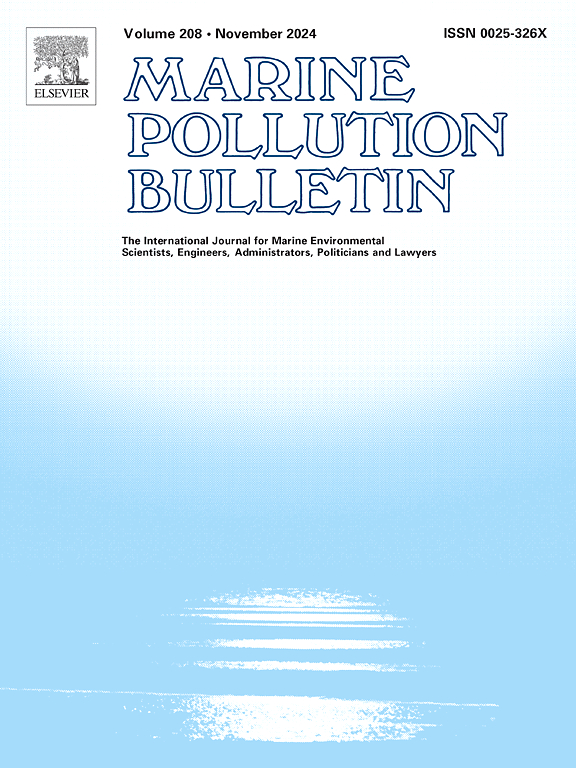Assessment of selected organic pollutants in sediments from a highly urbanized environment along the southeast coast of India
IF 5.3
3区 环境科学与生态学
Q1 ENVIRONMENTAL SCIENCES
引用次数: 0
Abstract
As part of the Marine Spatial Planning (MSP) for the Puducherry coast—a highly urbanized coastal area along India's southeast coast—an extensive assessment of organic pollutants was conducted in the sediments of the Thengaithittu Estuary, one of the major urban confluences in the region. Surface sediment samples were collected during both the dry season (June) and the wet season (September) in 2023 from six stations to measure polycyclic aromatic hydrocarbons (PAHs), polychlorinated biphenyls (PCBs), and organochlorine pesticides (OCPs), including DDTs. The results indicated that high molecular weight (HMW) PAHs predominated in both seasons, primarily from pyrogenic sources with concentrations ranging from 0.26 to 369.16 ng g−1 dw. Carcinogenic PAHs (C-PAHs) accounted for 51–98 % of the total PAHs, although the overall PAH levels remained below the Effect Range Low (ERL) threshold, reflecting a low ecological risk. PCBs were detected only at the fishing harbour region at the estuary's mouth, with concentrations varying from 17.16 to 130.04 ng g−1 dw, where 5Cl and 6Cl biphenyls comprised 80 % of the total composition. DDT levels, ranging from below detection limit (BDL) to 2.30 ng g−1 dw, suggested minimal recent inputs. The mean sediment quality guideline quotient (mSQGq) indicated low overall biological adverse effects across all stations. These findings offer essential baseline data regarding organic pollutant levels and ecological risks, emphasizing the need for enhanced management strategies to mitigate contaminant inputs and protect both the estuarine ecosystem and public health.

对印度东南沿海高度城市化环境中沉积物中选定有机污染物的评估
作为普都切里海岸(印度东南沿海高度城市化的沿海地区)的海洋空间规划(MSP)的一部分,对该地区主要城市交汇处之一的Thengaithittu河口沉积物中的有机污染物进行了广泛的评估。在2023年旱季(6月)和雨季(9月)采集6个站点的表层沉积物样本,测量多环芳烃(PAHs)、多氯联苯(PCBs)和有机氯农药(ocp),包括滴滴涕。结果表明,高分子量(HMW)多环芳烃在两个季节均占主导地位,主要来自热源,浓度范围为0.26 ~ 369.16 ng g−1 dw。致癌多环芳烃(C-PAHs)占总多环芳烃的51 - 98%,尽管总体多环芳烃水平仍低于影响范围低(ERL)阈值,反映了较低的生态风险。多氯联苯仅在河口渔港区域检测到,浓度范围为17.16 ~ 130.04 ng g−1 dw,其中5Cl和6Cl联苯占总组成的80%。滴滴涕水平从低于检测限(BDL)到2.30纳克g−1 dw不等,表明最近的最小投入。平均泥沙质量指导商(mSQGq)表明,所有监测站的总体生物不良影响较低。这些发现提供了关于有机污染物水平和生态风险的基本基线数据,强调需要加强管理战略,以减少污染物投入,保护河口生态系统和公众健康。
本文章由计算机程序翻译,如有差异,请以英文原文为准。
求助全文
约1分钟内获得全文
求助全文
来源期刊

Marine pollution bulletin
环境科学-海洋与淡水生物学
CiteScore
10.20
自引率
15.50%
发文量
1077
审稿时长
68 days
期刊介绍:
Marine Pollution Bulletin is concerned with the rational use of maritime and marine resources in estuaries, the seas and oceans, as well as with documenting marine pollution and introducing new forms of measurement and analysis. A wide range of topics are discussed as news, comment, reviews and research reports, not only on effluent disposal and pollution control, but also on the management, economic aspects and protection of the marine environment in general.
 求助内容:
求助内容: 应助结果提醒方式:
应助结果提醒方式:


